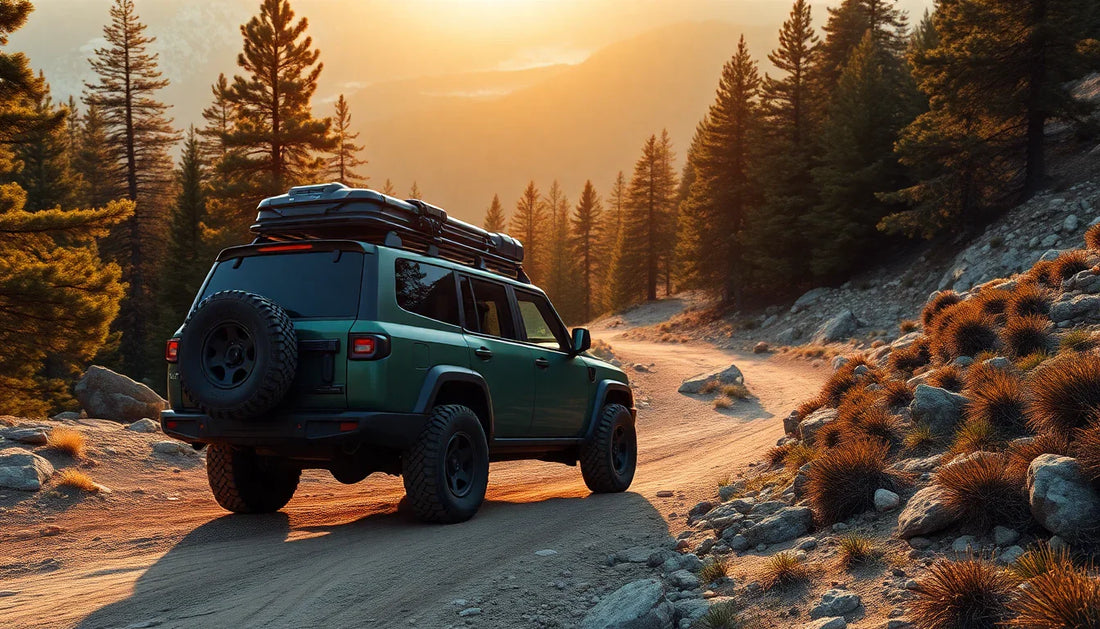
The Rise of Overlanding: How It Differs from Traditional Camping
Share
The outdoor adventure landscape has seen a remarkable shift in recent years, with a growing trend that sets itself apart from the traditional camping experience - overlanding. As the thirst for more immersive, self-reliant journeys through remote landscapes continues to rise, overlanding has emerged as a unique and captivating way to explore the great outdoors.
What is Overlanding?
At its core, overlanding is a form of vehicle-based travel and camping that emphasizes self-reliance, exploration, and a deep connection with the natural world. Unlike traditional camping, which often involves setting up a base camp and venturing out from there, overlanding is characterized by a continuous journey, with the vehicle serving as both a means of transportation and a mobile home.
The overlanding philosophy revolves around the idea of "journey over destination." Overlanders are not simply seeking to reach a specific endpoint, but rather to immerse themselves in the experience of the journey itself - navigating through diverse landscapes, encountering unexpected challenges, and adapting to the ever-changing environment around them.
Overlanding vs. Traditional Camping
While both overlanding and traditional camping share a love for the outdoors, the two experiences differ in several key ways:
Equipment and Gear
Overlanding typically requires a more comprehensive and specialized set of equipment. In addition to the essential camping gear, overlanders must also outfit their vehicles with features like roof-top tents, off-road tires, and advanced navigation systems. The focus is on self-sufficiency, with overlanders carrying supplies and equipment that allow them to be self-reliant for extended periods.
Travel Mindset
Traditional camping often involves setting up a base camp and exploring the surrounding area, while overlanding is characterized by a continuous journey. Overlanders embrace the spirit of exploration, seeking out remote and rugged destinations that may be inaccessible to traditional campers. The journey itself becomes the primary focus, with the destination serving as a mere waypoint along the way.
Objectives and Experiences
Traditional camping is often centered around relaxation, recreation, and connecting with nature in a more static setting. Overlanding, on the other hand, emphasizes a sense of adventure, personal growth, and a deeper immersion in the natural world. Overlanders are driven by a desire to push their boundaries, test their skills, and create lasting memories through their experiences.
Essential Overlanding Gear
Successful overlanding requires a carefully curated set of equipment and gear. Some of the essential items include:
- Capable off-road vehicle: A sturdy, high-clearance vehicle with four-wheel drive capabilities is a must for navigating challenging terrain.
- Roof-top tent or camper: These provide a comfortable and versatile sleeping solution, allowing overlanders to set up camp almost anywhere.
- Recovery gear: Items like tow straps, recovery boards, and winches are essential for getting unstuck or navigating difficult obstacles.
- Navigation and communication tools: GPS devices, satellite phones, and two-way radios ensure overlanders can stay connected and find their way, even in remote areas.
- Survival and emergency equipment: First-aid kits, fire starters, and emergency shelters are crucial for ensuring safety and self-reliance.
- Cooking and camp amenities: Portable stoves, water filtration systems, and comfortable camp furniture enhance the overall overlanding experience.
Overlanding Destinations in the USA
The United States offers a diverse and captivating landscape for overlanding enthusiasts. Some of the top destinations include:
- The American Southwest: Regions like the Mojave Desert, the Colorado Plateau, and the Rocky Mountains provide a stunning backdrop for overlanding adventures.
- The Pacific Northwest: From the rugged coastlines of Oregon and Washington to the lush forests and mountain ranges, this area offers a wealth of overlanding opportunities.
- The Appalachian Mountains: The winding roads and remote trails of the Appalachian region provide a unique overlanding experience, with a focus on history and cultural exploration.
- Alaska and the Yukon: For the truly adventurous, the vast and untamed landscapes of Alaska and the Yukon offer a true test of overlanding skills and self-reliance.
Practical Tips for Aspiring Overlanders
Embarking on an overlanding journey requires careful planning and preparation. Here are some practical tips for those new to the overlanding lifestyle:
- Vehicle selection and modification: Choose a capable off-road vehicle and outfit it with the necessary equipment and accessories.
- Route planning and navigation: Research potential routes, consider terrain and weather conditions, and equip yourself with reliable navigation tools.
- Safety and emergency preparedness: Familiarize yourself with survival techniques, pack essential emergency gear, and ensure you have the necessary skills and knowledge to handle unexpected situations.
- Packing and organization: Carefully plan and pack your gear, prioritizing efficiency and accessibility to ensure a smooth and stress-free journey.
- Embracing the journey: Approach your overlanding adventure with a spirit of exploration, flexibility, and a willingness to adapt to the ever-changing environment.
Conclusion
As the overlanding movement continues to gain momentum, it offers a unique and captivating way to experience the great outdoors. By embracing the spirit of self-reliance, exploration, and a deep connection with nature, overlanders are redefining the way we think about outdoor adventure. Whether you're a seasoned camper or a newcomer to the world of overlanding, the opportunity to embark on a transformative journey through remote and rugged landscapes is one that promises to leave a lasting impact on both the body and the soul.
